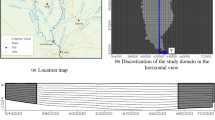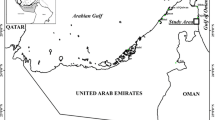Abstract
The Salalah central sewage treatment plant has been designed to treat 20,000 m3/day at the first stage and two further stages to double the initial capacity. The plant currently (2005) treats more than 15,000 m3/day effluents to a tertiary level, and after chlorination phase, the effluents are recharged into tube wells in a line parallel to the coast. The process aims to help stabilize the seawater interface and a part to be recovered from hand-dug wells/boreholes further inland and downstream. A three-dimensional flow and solute advection transport model was developed to assess the effectiveness of the proposed recharge scheme and to track the solute transport with respect to the design system. The advection transport model predicted that in 2020 the maximum pathlines of the injection fluids would reach the abstraction wells that are located 600 m, southward of the injection bores in about 1-year travel time in the case of the no-management interference and more than that southward under management interference. The developed flow predicted the wedge of the saline intrusion in 2019 is tracked up to 2.7 and 3.4 km from the shoreline with the injection and without the injection, respectively under constant underflow. The injection scheme is effective in pushing back the saline zone front by 700 m. This study argues that the treated wastewater would help to increase the water levels at the vicinity of the injection line and to reduce the influence of saline inflows from the coast. The reclaimed sewage recharge scheme is examined in the case of the Salalah coastal aquifer using groundwater simulation, which can also be applied to other regions with similar conditions.















Similar content being viewed by others
References
Al-Sabahi AMA, Sharples P (2000) Masterplan for groundwater pollution protection in the Sultanate of Oman. MRMEWR. Report
Al Salem SS (2004) Health risks and regulations in aquifer recharge with recycled water. Symposium on challenges post of wastewater projects from 22–24 March 2004, organized by Dhofar Municipality in Salalah, Oman (unpublished paper)
D&MI (Dames, Moore International) (1992) Water and wastewater Masterplan for Salalah: Office of the Minister of State and Governor of Dhofar. Sultanate of Oman, Salalah
D&MI (1993) Salalah wastewater project; Salalah groundwater recharge; design study; Final report: Office of the minister of state and governor of Dhofar. Dhofar municipality, Salalah
ENTEC (Euro Nato Training Engineering Centre) (1998) Consultancy services for the study of development activities on groundwater quality of Wadi Adai, Al Khawd and Salalah Wellfield protection zones, Contract No 96–2133, Final Report. Vol.1. Former Ministry of Water Resources, Sultanate of Oman
HMR Environmental Engineering Consultants (2004) Implementation of the groundwater pollution protection master plan; Salalah wastewater disposal; Tender No. 13/2003. Ministry of Regional Municipalities. Environment and Water Resources, Sultanate of Oman
McDonald MG, Harbaugh AW (1988) A modular three-dimensional finite-difference groundwater flow model. USGS open-file report 83–875: Modelling techniques, book 6, chapter A1
Mott MacDonald (1996) A master plan for groundwater pollution protection, master plan- part one (draft). Main report, MRMEWR, Sultanate of Oman
Oman Census (2003) Ministry of National Economic, Sultanate of Oman
Omani Drinking Water Standards (O.S 8/1998) (1998) Ministry of Commerce and Industry. Directorate General for Specifications and Measurements, Sultanate of Oman
Peavy H, Rowe D, Tchobanoglous G (1988) Environmental engineering: McGraw-Hill international editions, Civil Engineering Series, 699 pp
Qatan A, Abu-Ashour J (2002) Impact of treated wastewater recharge in Salalah coastal aquifer on groundwater quality. Unpublished master thesis. Sultan Qaboos University, Sultanate of Oman
Renardet SA and Partners Consulting Engineering LLC (2004) EIA study for development of salalah municipal landscape areas project: an irrigation system plan of municipal landscape areas and roadside plantation at Salalah. Office of the Minister and Governor of Dhofar. Dhofar Municipality, Sultanate of Oman
Royal Decree 115/2001 and Ministerial decision 145/93 dated 13th June (1993) The guidelines for the reuse and disposal of the treated wastewater, MRMEWR, Sultanate of Oman
Shammas MI (1998) Groundwater pollution in Salalah plain aquifer; Oman. Unpublished master of thesis report. Royal institute of technology (KTH), Sweden. 72 pp
Shammas MI, Jacks G (2007) Seawater intrusion in the Salalah plain aquifer, Oman. Environ Geol J. (doi:10.1007/s00254-007-0673-2)
SSDSCo (Salalah Sanitary Drainage Services) (2000) Drilling of recharge, monitoring and observation wells at Salalah, Sultanate of Oman
Zubari WK (1997) Towards the establishment of a total water cycle management and reuse program in the GCC countries. In: Conference proceedings of the third gulf water on towards efficient utilization of water resources in the gulf, Muscat, Sultanate of Oman 8–13 March, 1997, vol 1, 1–15
Acknowledgments
The would like to thank Barry P. Jupp of Ministry of Regional Municipalities, Environment and Water Resources (MRMEWR), Sultanate of Oman for the language corrections.
Author information
Authors and Affiliations
Corresponding author
Rights and permissions
About this article
Cite this article
Shammas, M.I. The effectiveness of artificial recharge in combating seawater intrusion in Salalah coastal aquifer, Oman. Environ Geol 55, 191–204 (2008). https://doi.org/10.1007/s00254-007-0975-4
Received:
Accepted:
Published:
Issue Date:
DOI: https://doi.org/10.1007/s00254-007-0975-4




